 For those that have been following the ultimate success plans posts, you know that this has been a pursuit that I have been perfecting for over 3 years. I have a big and embarrassing confession to make though. You see, when I first started preparing to write the Ultimate Personal Success Plan e-Book and the posts for this new version; I actually wasn’t sure how it was going to end. Due to some successes, failures, and struggles I had in 2012, I knew I needed to make some changes to the plan, but I wasn’t sure what to do. So I delayed, and delayed as long as I could.
For those that have been following the ultimate success plans posts, you know that this has been a pursuit that I have been perfecting for over 3 years. I have a big and embarrassing confession to make though. You see, when I first started preparing to write the Ultimate Personal Success Plan e-Book and the posts for this new version; I actually wasn’t sure how it was going to end. Due to some successes, failures, and struggles I had in 2012, I knew I needed to make some changes to the plan, but I wasn’t sure what to do. So I delayed, and delayed as long as I could.
The really embarrassing part of this is that I consult with organizations on creating a culture of execution in organizations, and here I found myself, utterly failing to execute because I was not sure of the direction I was going in. I tell my clients when they are struggling with this same problem that it is usually better to start executing in any direction, than no direction. I also felt compelled, OK stressed to start the posts because many were asking me for it.
So I took my own advice and just started writing, i.e. executing, in hopes that the answer would work itself out. Two weeks and 4 posts into the writing and I still was not sure exactly where this was going, nor what I was missing. Then it all came together. A friend sent me something that gave me an idea. That idea then blossomed, and then blossomed again, and again, and again until I had created something I was passionate about and confident about. Now I truly feel like I have the recipe for the ULTIMATE ANNUAL PERSONAL SUCCESS PLAN, and IT’S AWESOME!
Everything that has been written so far is valuable for this plan. So don’t worry if you think I wasted your time. I have greatly extended the power of the plan and built huge changes to make for a more successful year, but more than that, I have created an execution structure for your success plan. The images below are of a self-contained excel workbook. This is a thing of beauty, because it not only lets you define everything, and there are some important new parts to define, but it lets you track your progress the whole way. It has a completely self-contained dynamic database to keep the sheet clean throughout the year.
Images for the NEW Ultimate Annual Personal Success Plan!
This is the page where you will define all the parts of the success plan for the year. I’ll be writing more about the components in another post.

This is the monthly goals sheet. This is where you will track your your progress each month. Again, I will be writing more about this in another post.
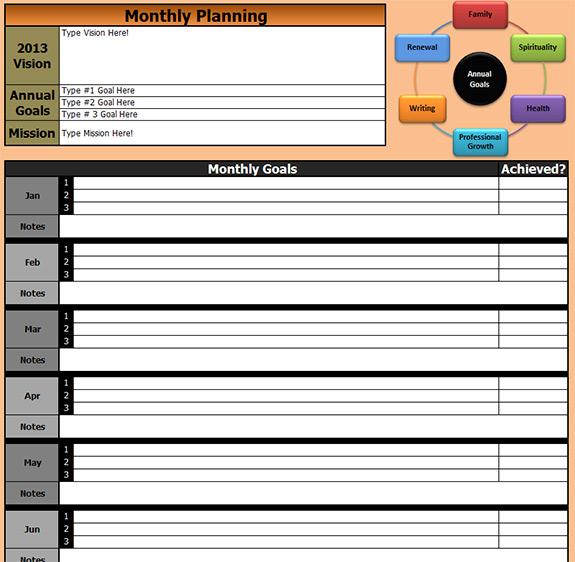
Next is the most important sheet and the one you will use the most. It is the Weekly Planning, Tracking & Review sheet. This is the first part of the sheet. There is a drop down that connects to an internal excel “database” so you can track your goals all year long. It’s super cool, and provides part of the execution structure I mentioned earlier. I will explain this in more detail in a later post.
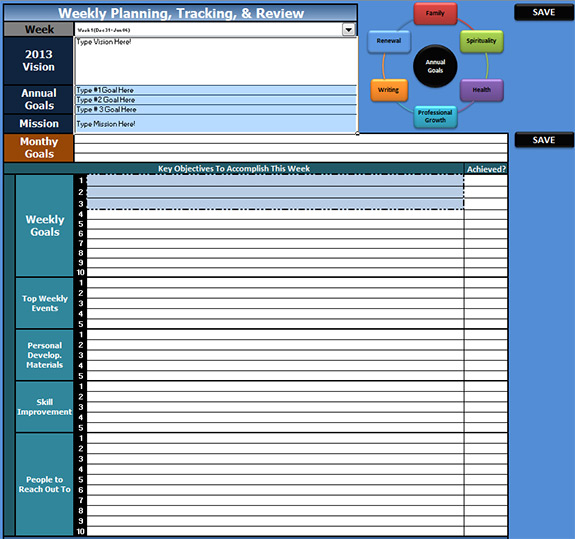
The second part of the sheet is for tracking habits and reviewing your week. How can you be a success without mastering your habits and constantly reviewing your progress. More on this in a future post!
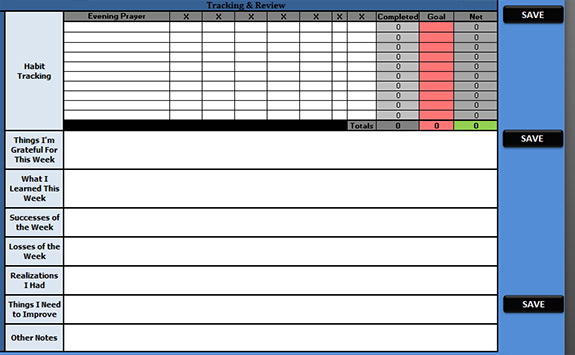
Below is a report for reviewing all of your consolidated reports from the weekly review section. This will be great to tracking yoru progress over the course of the year. More in another post…
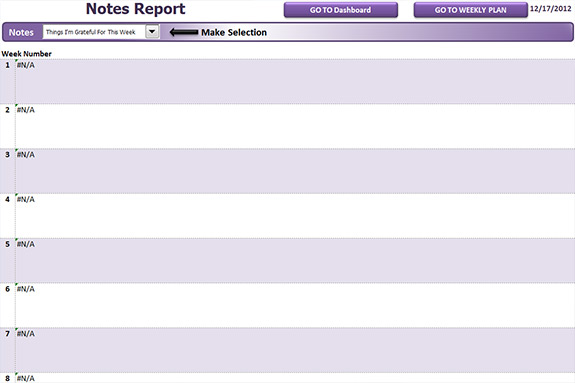
You can’t have a cool excel workbook, nor success plans, without a dashboard. This dashboard tracks your achievement ability over the course of the year. Much more on this is forthcoming…
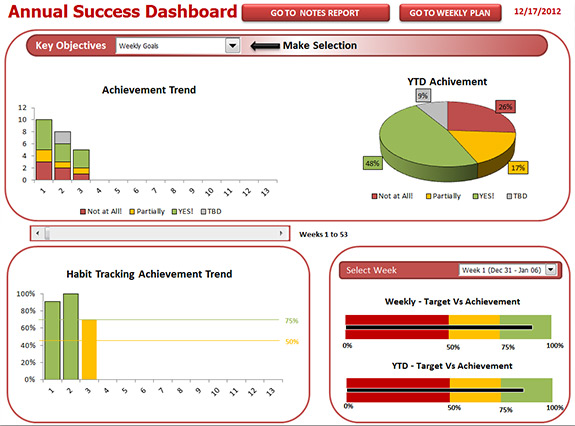
Please leave a comment and let me know what you think. I hope you are excited to have the best year you have ever had!

 Sometimes the best laid plans get derailed, which is exactly what happened to me last week. I had a epiphany that completely changed the outcome of the Ultimate Personal Success Plan. It took me a week to figure out exactly what I was going to do, but the result of this blast of revelation makes the Ultimate Annual Personal Success Plan so much more powerful. So for a week posts were not published and I have been pretty silent as I developed this plan, more on this later…
Sometimes the best laid plans get derailed, which is exactly what happened to me last week. I had a epiphany that completely changed the outcome of the Ultimate Personal Success Plan. It took me a week to figure out exactly what I was going to do, but the result of this blast of revelation makes the Ultimate Annual Personal Success Plan so much more powerful. So for a week posts were not published and I have been pretty silent as I developed this plan, more on this later… After the last post, I hope you have a bunch of things written down that you want to accomplish in your life and in more specifically in the next year. We are going to come back to that list shortly. I firmly believe that success in certain areas of one’s life can equal extreme failure in other areas of one’s life, if one is not careful. For example, how successful would I really be if I wrote 4 books next year; but at the same time, alienated my family and friends because I never spent time with them? I also believe that the synergy of success from one area, can fuel passion and greater achievement in another area. So take that same example, if I met the needs and wishes of my spouse and family, and thus ended up improving my relationships, that joy and success would carry over and make me more passionate and motivated to duplicate that success in another area of my life, like writing books. Plus I would probably have more support from my wife and family for doing so.
After the last post, I hope you have a bunch of things written down that you want to accomplish in your life and in more specifically in the next year. We are going to come back to that list shortly. I firmly believe that success in certain areas of one’s life can equal extreme failure in other areas of one’s life, if one is not careful. For example, how successful would I really be if I wrote 4 books next year; but at the same time, alienated my family and friends because I never spent time with them? I also believe that the synergy of success from one area, can fuel passion and greater achievement in another area. So take that same example, if I met the needs and wishes of my spouse and family, and thus ended up improving my relationships, that joy and success would carry over and make me more passionate and motivated to duplicate that success in another area of my life, like writing books. Plus I would probably have more support from my wife and family for doing so.
 On June 1st of 2012, I released a guest post on a personal branding site that went viral. I couldn’t believe how much it was shared on Twitter and other social networks in such a short amount of time. I was invited to start-off the first day this Personal Branding Blogathon, put on by Peter Sterlacci at
On June 1st of 2012, I released a guest post on a personal branding site that went viral. I couldn’t believe how much it was shared on Twitter and other social networks in such a short amount of time. I was invited to start-off the first day this Personal Branding Blogathon, put on by Peter Sterlacci at  Success Plan, Personal Success Plan, Annual Plan, Resolutions, Goals… nope, lets combine it all into The Ultimate Annual Personal Success Plan, now is the time! As many of my readers have seen I have been working on an e-book for the Ultimate Personal Success Plan. As I have been working on it there has been one thing that kept bugging me. – I hate e-books… Usually when someone gives away an e-book, I download it, I browse through it, and then it goes in a folder where e-books go to rest and ultimately sit unopened forever more.
Success Plan, Personal Success Plan, Annual Plan, Resolutions, Goals… nope, lets combine it all into The Ultimate Annual Personal Success Plan, now is the time! As many of my readers have seen I have been working on an e-book for the Ultimate Personal Success Plan. As I have been working on it there has been one thing that kept bugging me. – I hate e-books… Usually when someone gives away an e-book, I download it, I browse through it, and then it goes in a folder where e-books go to rest and ultimately sit unopened forever more. Jim Valvano said, “Be a dreamer. If you don’t know how to dream, you’re dead.” No matter how you feel after the election, and no matter what comes out of the next few weeks; you must keep YOUR dream alive. Governments, kings, rulers, and bad relationships cannot kill your dream. They may dampen your spirits, crush your hopes, and cut into your nerves; but they cannot take away YOUR dream.
Jim Valvano said, “Be a dreamer. If you don’t know how to dream, you’re dead.” No matter how you feel after the election, and no matter what comes out of the next few weeks; you must keep YOUR dream alive. Governments, kings, rulers, and bad relationships cannot kill your dream. They may dampen your spirits, crush your hopes, and cut into your nerves; but they cannot take away YOUR dream. Back in 2011 I was working for a company as Chief Operations Officer. In 2009 I had sold my company to this organization, but after the first year or so, I knew that it wasn’t going to be the place to hang my hat for the rest of my career. So I began thinking about and preparing for a career change. I had sold my company because I had created a cloud computing model that had huge potential. I was passionate about cloud computing and technology and felt I was on the forefront of the industry (which I was).
Back in 2011 I was working for a company as Chief Operations Officer. In 2009 I had sold my company to this organization, but after the first year or so, I knew that it wasn’t going to be the place to hang my hat for the rest of my career. So I began thinking about and preparing for a career change. I had sold my company because I had created a cloud computing model that had huge potential. I was passionate about cloud computing and technology and felt I was on the forefront of the industry (which I was).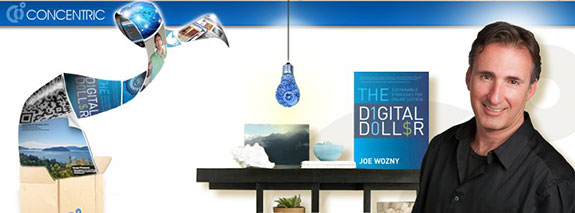 About 4 or 5 years ago, I wrote an article for a site and discussed the idea that it seems like everyone and their dogs are becoming social media experts. Over the years I have read books about Twitter, Facebook, Blogging, Social Media, and Search Engine Optimization; and to be frank, most of them are not that good, especially for the most important demographic of this knowledge – leaders and business owners trying to grasp this new digital landscape. I was afraid that the right book was not going to come along.
About 4 or 5 years ago, I wrote an article for a site and discussed the idea that it seems like everyone and their dogs are becoming social media experts. Over the years I have read books about Twitter, Facebook, Blogging, Social Media, and Search Engine Optimization; and to be frank, most of them are not that good, especially for the most important demographic of this knowledge – leaders and business owners trying to grasp this new digital landscape. I was afraid that the right book was not going to come along.
 According to Merrill Lynch, “50% of employee skills become outdated in 3 to 5 years.” WOW, when I read this statistic, it really surprised me. Many leaders think that the experience of just doing the required work, day in and day out, is enough to keep their employees knowledgeable to optimally perform their duties. Unfortunately that is not true at all.
According to Merrill Lynch, “50% of employee skills become outdated in 3 to 5 years.” WOW, when I read this statistic, it really surprised me. Many leaders think that the experience of just doing the required work, day in and day out, is enough to keep their employees knowledgeable to optimally perform their duties. Unfortunately that is not true at all.